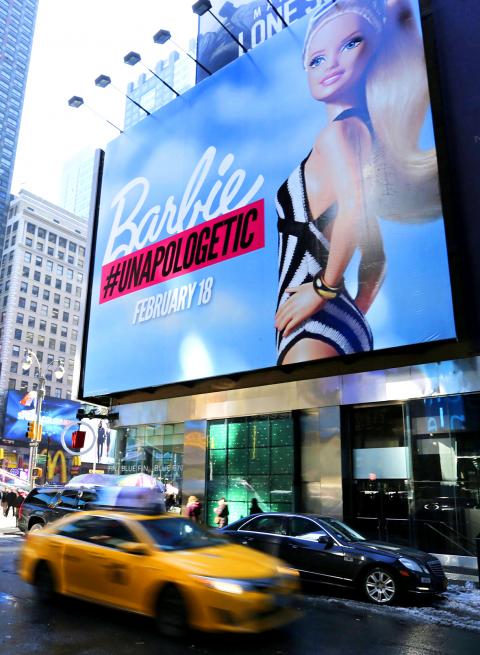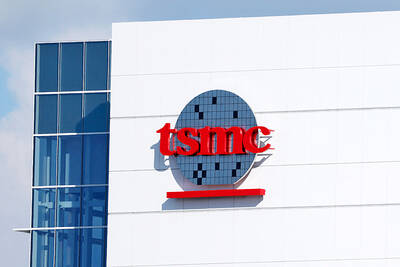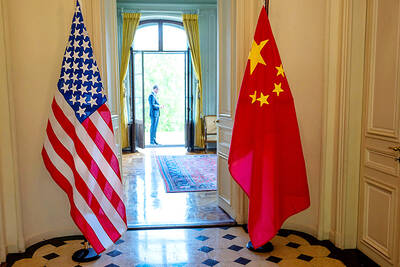Barbie has been many things in her life: A doctor, a paleontologist, an astronaut, a cheerleader, a race car driver and a candidate for the US presidency.
Now, on the threshold of her 55th birthday, the world’s most famous doll is stirring up a social media frenzy with her debut in Sports Illustrated’s 50th anniversary swimsuit edition.
In a tie-in with toymaker Mattel Inc, the top-selling US sports weekly has cast the leggy — if anatomically impossible — all-American doll on a mock cover, sporting a black-and-white one-piece reminiscent of the one she wore when introduced in 1959.

Photo: AFP
“The Doll that Started it All,” reads the headline on the cover, which is being wrapped around some issues of the magazine.
The Twitter hashtag #unapologetic features in the joint marketing campaign, which will also include ads in the magazine.
“From its earliest days, Swimsuit has delivered a message of empowerment, strength and beauty, and we are delighted that Barbie is celebrating those core values in such a unique manner,” M.J. Day, the Sports Illustrated senior editor responsible for the iconic and highly lucrative special edition, said in a statement.
Sports Illustrated launched the swimsuit edition in 1964 to prop up circulation between the US football and baseball seasons. Now a stand-alone product, it is the best-selling of Time Inc’s titles.
The swimsuit issue comes out on Tuesday with a bikini-clad Chrissy Teigen, Nina Agdal and Lily Aldridge on the cover, posing on a sun-kissed tropical beach with their toned buttocks well exposed.
However, it is Barbie — or more precisely the notion of giving her top billing in a magazine that pitches sun, sea and sex to impressionable US males in the dead of winter — that has fired up the blogosphere.
“This is what is known as obvious trolling,” Mary Elizabeth Williams wrote at Salon.com. “You plan on getting mad again this year about hot, barely clothed women in a sports magazine again this year, world? Here. Here’s a plastic one ... a freaking mass-produced doll.”
“Just as the swimsuit issue isn’t for the kids, Barbie isn’t for the grown-ups either,” Mommyish.com editor Eve Vawter added. “Barbie is no longer just a doll. She is a sex doll. Think about that the next time your daughter wants one in the toy aisle.”
Alas, on the eve of the New York Toy Show and hard on the heels of New York fashion week, Barbie is grappling with the middle-aged fear that she is no longer hot stuff.
Publicly listed Mattel revealed in January that worldwide gross sales of its Barbie products fell 6 percent last year and 3 percent in 2012, putting a drag on the profitability of the world’s biggest toy manufacturer.
“We just didn’t sell enough Barbie dolls,” Mattel chief executive Bryan Stockton said in a conference call with financial analysts, although its other doll lines, such as Monster High, are faring better.
Barbie — whose brand is valued at US$3 million, a tad more than Oprah Winfrey’s estimated worth — is no stranger to controversy.
She has regularly been faulted in the past for setting an unrealistic example for young girls with her impossibly lithe figure, fabulous wardrobe and storybook romance with dashing boyfriend Ken.
If 29cm-tall Barbie was a full-grown US woman, she would have a 81cm bust, a 40cm waist and 74cm hips, as well as a child’s size three foot, according to Rehabs.com, a Web site that addresses eating disorders.
Lindsey Feitz, who lectures on gender and women’s studies at the University of Denver in Colorado, considered it “ethically dubious” to use a girl’s doll to sexualize girlhood in a magazine seen mainly by men.
“We’ve evolved from the ink drawings of pin-ups in the 1940s to chronic Photoshopping and digital body alterations of today’s cover models,” Feitz told reporters by e-mail.
“And now the model has disappeared and been replaced with a plastic representation of a sexy girl/woman. It’s ironic,” she added.

Real estate agent and property developer JSL Construction & Development Co (愛山林) led the average compensation rankings among companies listed on the Taiwan Stock Exchange (TWSE) last year, while contract chipmaker Taiwan Semiconductor Manufacturing Co (TSMC, 台積電) finished 14th. JSL Construction paid its employees total average compensation of NT$4.78 million (US$159,701), down 13.5 percent from a year earlier, but still ahead of the most profitable listed tech giants, including TSMC, TWSE data showed. Last year, the average compensation (which includes salary, overtime, bonuses and allowances) paid by TSMC rose 21.6 percent to reach about NT$3.33 million, lifting its ranking by 10 notches

Popular vape brands such as Geek Bar might get more expensive in the US — if you can find them at all. Shipments of vapes from China to the US ground to a near halt last month from a year ago, official data showed, hit by US President Donald Trump’s tariffs and a crackdown on unauthorized e-cigarettes in the world’s biggest market for smoking alternatives. That includes Geek Bar, a brand of flavored vapes that is not authorized to sell in the US, but which had been widely available due to porous import controls. One retailer, who asked not to be named, because

SEASONAL WEAKNESS: The combined revenue of the top 10 foundries fell 5.4%, but rush orders and China’s subsidies partially offset slowing demand Taiwan Semiconductor Manufacturing Co (TSMC, 台積電) further solidified its dominance in the global wafer foundry business in the first quarter of this year, remaining far ahead of its closest rival, Samsung Electronics Co, TrendForce Corp (集邦科技) said yesterday. TSMC posted US$25.52 billion in sales in the January-to-March period, down 5 percent from the previous quarter, but its market share rose from 67.1 percent the previous quarter to 67.6 percent, TrendForce said in a report. While smartphone-related wafer shipments declined in the first quarter due to seasonal factors, solid demand for artificial intelligence (AI) and high-performance computing (HPC) devices and urgent TV-related orders

MINERAL DIPLOMACY: The Chinese commerce ministry said it approved applications for the export of rare earths in a move that could help ease US-China trade tensions Chinese Vice Premier He Lifeng (何立峰) is today to meet a US delegation for talks in the UK, Beijing announced on Saturday amid a fragile truce in the trade dispute between the two powers. He is to visit the UK from yesterday to Friday at the invitation of the British government, the Chinese Ministry of Foreign Affairs said in a statement. He and US representatives are to cochair the first meeting of the US-China economic and trade consultation mechanism, it said. US President Donald Trump on Friday announced that a new round of trade talks with China would start in London beginning today,